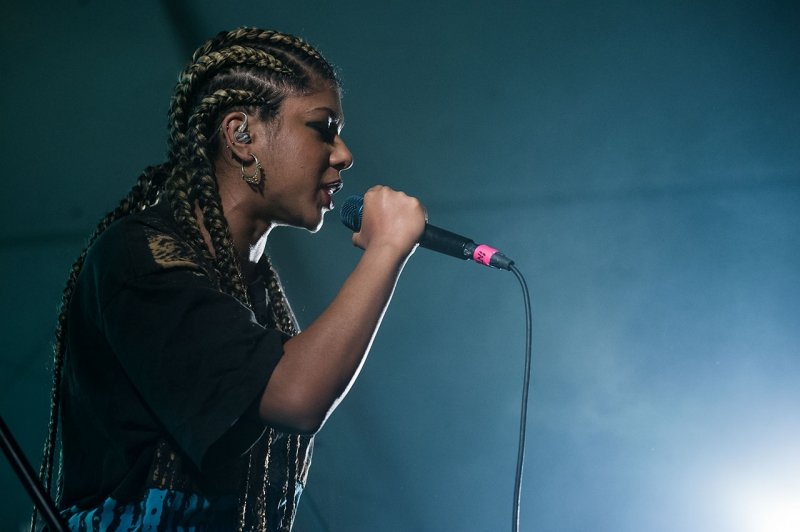Aussie electro-punk-rocker Ecca Vandal is an ambassador for an empowering community-focused project called ‘Voice for Change’. The project consists of a collection of mini-documentaries; each telling the story of a different urban music, hip-hop or sporting personality from a diverse and multicultural background and aims to inspire Australia’s next generation to realise their aspirations and goals. In her doco, Vandal powerfully addresses her multicultural upbringing, her personal journey through cultural disenfranchisement and how art became a means of healing and transformation.
As a distinctive and articulate woman of colour, Vandal seeks to give voice to the minor, marginal and misbehaving – the elements of our society deemed jagged and ugly. Only by dismantling narratives that paint poor people, brown people and rebellious people as useless leftovers does Vandal believe that we can move into a properly harmonious society. Undoubtedly, her upcoming album will do its best to fight against the system and to teach to live and die (paraphrased from Bob Marley).
Music Feeds sat down with Ecca Vandal to delve further into the issues of multicultural identity, oppression and using art as a force for expression and empowerment. Here are some concepts we uncovered.
A multicultural medley
Ecca Vandal, a Sri-Lankan South African Australian, is an example of multi-racial, globally aware individuals born from cross-cultural interaction (the same should be indicative of ‘white’ people, who possess in their blood an innumerable ethnicity). These people and families are microcosms of a greater multicultural matrix, managing a complicated psycho-cultural economy to harmonise an internal mass of difference. Ecca Vandal, for example, must ask, “What does it mean to be Sri-Lankan South African and Australian – all at once? Is there some extant hierarchy that I should apply? Can I contort and squeeze all these bits into a single identic-box?” All such questions inform the person-making that we all enact as we run the rope of being.
Multiracial and multicultural people should be at the rostrum to contest with those sceptical of ethnic pluralism. Having been the existential and bodily grounds of a messy mulatto-medley, they need merely point at themselves. They are evidence of peaceful coexistence, the sweet intermarriage of cultures. As Victor Hugo said, “Night and the day, when united, bring forth the beautiful light.”
This is Ecca Vandal’s story:
Ecca Vandal: “We moved to Australia when I was 4 years old and we were lucky enough to move into a good area. A lot of my family were here. So it was a relatively smooth transition. However, I had to deal with going to school, largely in a white suburb, where all my classmates were white. I was really the one that stood out. So I understood in some general, unenlightened way at around that time that I was different, and all these questions were darting through my mind. As I grew older I began to build those answers, and figure myself into existence.
“There was a time probably towards growing up and moving towards being a teenager when it all clicked. I was trying desperately to separate myself – my identity – from my parents, in an effort to become an adult and make my own decisions. But, my parents were pulling me in one cultural direction and the totality of Australian culture, positives and negatives, were pulling me in a different direction.
“That was a big struggle for me. At the time, I really desired to be involved with what my friends were doing, but that did not fit comfortably with the cultural framework of my parents and sisters. There was a very different paradigm at play in my familial space. It was hard for them to understand. The Tug of War was obvious.
“It was a double-noticing of difference. I was different to my parents and their culture but I was of my parents and my culture and therefore different to a majority of Australians (at the time). I saw my parents move across two countries to find a stable home – a place where they felt safe and welcome. I absorbed some of the turmoil that still colours my parents. These conflicting feelings were formative in the fighting spirit that I have today.
“Now, I am quite vocal. I too have felt that I am a foreigner, I too have felt isolated. When I see these kids in ‘Voice For Change’ I really relate to what they must be feeling as they attempt to trek through a country that is fundamentally foreign to them. So that is something that really resonated with me with this project. I saw lots of parallels with my personal story.”
It’s time to fight
Jacqui Lambie recently challenged the Liberals and One Nation for their cuts to welfare. Her voice staggered as she lambasted the new conservative block for their diminishing and disabling of the working class ‘battler’. These cuts will have substantive implications for all those in the working class, indiscriminate of race, sex, sexuality and creed. To fight this, activism and politic must become intersectional, which is to say that it must carefully ally the whole constellation of struggles and strugglers.
Through her work with ‘Voice For Change’, Vandal hopes to help people concentrate on objectives that do not burnish their particular faces, but rather illuminate them. Giving them the tools to step in sync and swing their fists in choreographed congress.
Ecca Vandal: “In ‘Voice for Change’, our roles are to help the kids find their voice, and ultimately become voices for change themselves. I personally hope that this project has a ripple effect. In the short-term, I hope to encourage them to believe in themselves and to be more than society’s racial profiling and classist reductionism paints them to be.
“When you actually meet these young people, you see that they are capable, strong and driven. They want to be the best versions of themselves. They have the raw material, they just need the right tools and conditions. If we can place the tools in their hands, and inspire them to believe, envision, for their minds to be challenged and for their spirit to be uplifted, they will feel a sense of worth and belonging.
“Each of us needs to build and support these initiatives more than ever. We need to be as bold as possible with our voices, more than ever. Especially when it comes to the sisterhood. It is time for women to step up and speak louder. We need to support and band together each other more. We need to celebrate each other’s wins.
“We need to be more inclusive with who our leaders can be and not just look to long-standing traditions and oligarchies. We need to start breaking down historical stereotypes, moulds and systems. We can only do this by being loud, active, fearless and persistent. No more walking on eggshells.
“In writing my upcoming album, I have definitely found that certain topics and issues request themselves to be revealed. I listened to the request and I wrote about the refugee crisis, detention centres and domestic violence. Those particular topics I feel very strongly about, and I have included them in my lyrics.”
Art as powerful emotion
One of my favourite art theorists, R. J. Collingwood believed that the key to art was emotion. Art was not some formal assemblage of aesthetic qualities, but an act of concrete expression. Art arose from a ‘helpless and oppressed condition’, a state where one says simultaneously, ‘I feel’ and ‘I don’t know what I feel.’ By giving artifactual form to feeling, it drags a seemingly unknowable perturbation into the light. What seemed to be cloaked immutably in the unconscious is embodied, realised in the world.
Collingwood would have loved Ecca Vandal. For Vandal, music performs a similar revelatory function and awakens her to her psychic forest.
Ecca Vandal: “My music is a form of expression. In it, there is certainly a heavy and confronting ethos. This is because it is an intense form of emotional expression, and I choose to bring this to my performance. It is me expressing myself, the entirety of my cultural being and all the messy and confusing things that reside in my heart and mind. It is something that I choose to bring because I want to empower other women.
“I personally have had to overcome certain insecurities with myself. Palpable feelings of foreignness or difference. You notice your skin and feel your disparity in white space. But, those moments are now few and far between. I only feel out of my comfort zone for a short amount of time, because I have learnt to overcome those feelings by being really sure and proud of my identity. Importantly, I have achieved this by bringing my identity, musical heritage and cultural heritage to the framework of my artistry. Sonically, there are influences with the big, voluminous beats and fat drums – those are linked to my Sri Lankan culture. Even melodically there are some intricate links to Southern Indian/Sri Lankan sonics.
“My artistry is driven by my cultural and personal individuality. I must be, and you must be, okay with your strange, unique and confounding existence. Over the past few months, I have been managing various people’s opinions and expectations of my artistic self. ‘You should sound like this’, ‘maybe you should change this’ or ‘do it like this’, they say, trying to shave down the edges so that I can fit neat and tidy into a box, in this case, some warped and ancient stereotype of the ‘female performer’.
“I have had to resist this kind of pressure to simplify and quieten. I need to be comfortable with myself, being on the outside, being different. ‘It is okay’, I say to myself. So, self-acceptance is fundamental for me and my art.”
–
You can watch all the ‘Voice For Change’ episodes, including one with Sampa The Great, B Wise, Urthboy and Diafrix, here.












